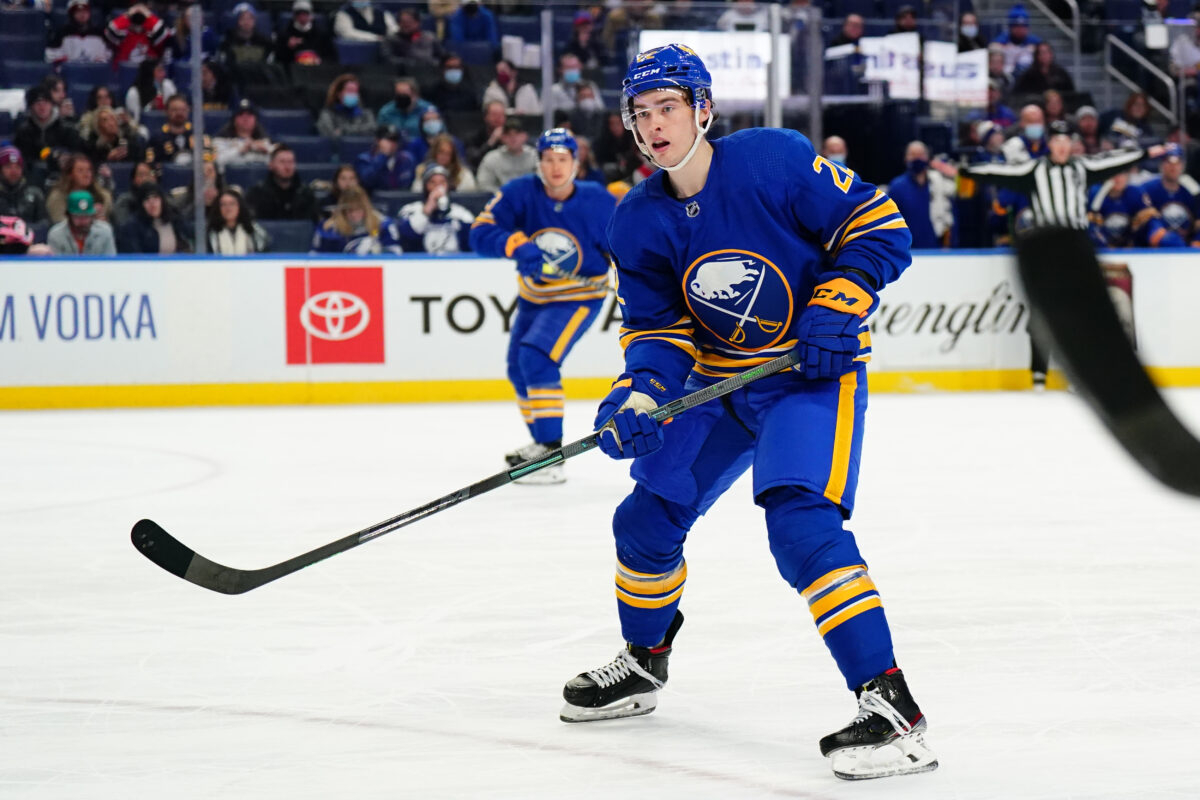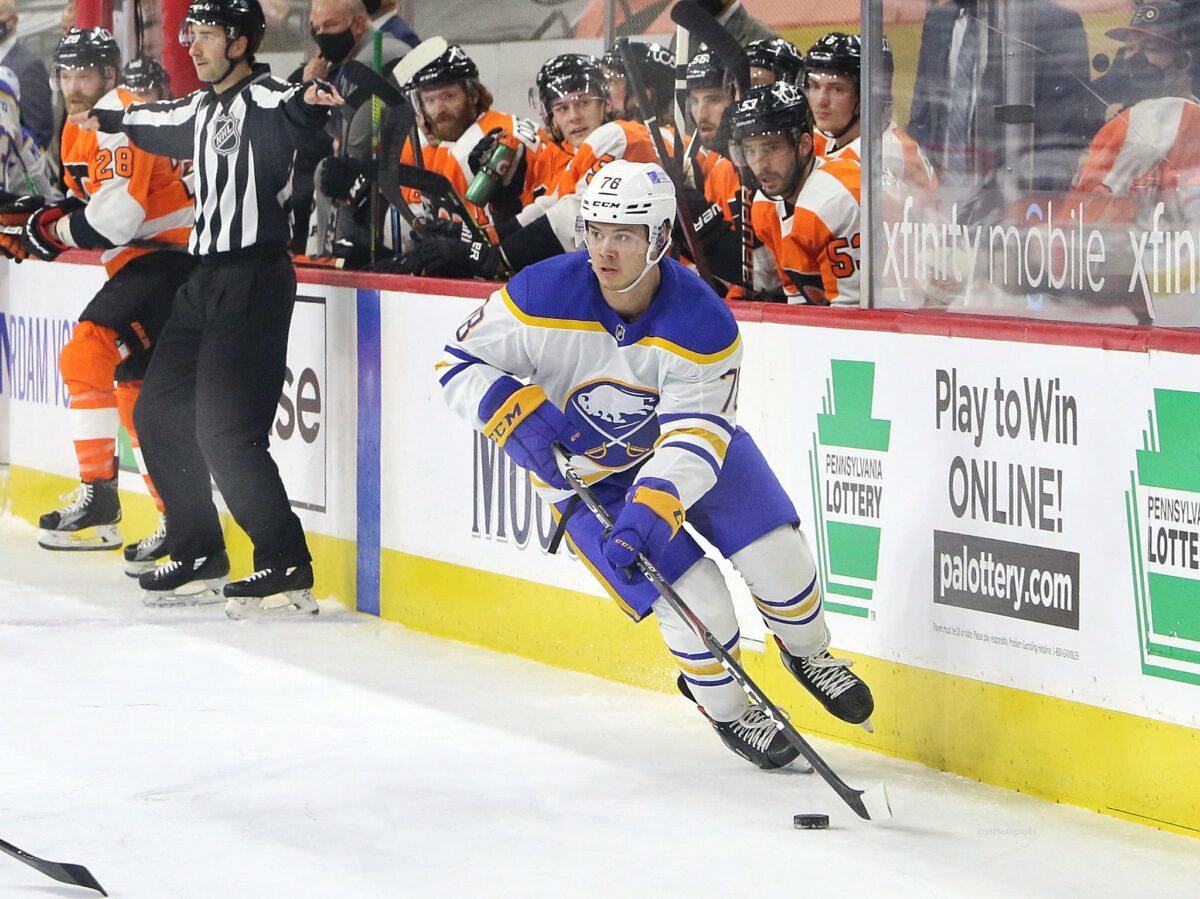With the season rapidly approaching, the scrutiny over who was or wasn’t signed by the Buffalo Sabres can begin to subside, and attention should turn to the opening night roster. Training camp provides players a chance to compete for a roster spot, and the organization has competition at virtually every position. Training camp will be a must-watch to see how it all unfolds and who starts the season in Buffalo.
Sabres Forward Depth Stokes Internal Competition
While the Sabres still have work to do to make the forward group a top-tier unit, they have the pieces needed to be competitive this season. Though most of their forward group is set, the bottom of the lineup has a few interesting position battles. Jack Quinn and JJ Peterka will have every opportunity to make the roster, and they appear primed to take another step in their development after strong seasons with the Rochester Americans. They also signed Riley Sheahan in the offseason, and Vinnie Hinostroza was brought back for a second year.

Having this kind of internal competition is very exciting. The Sabres haven’t had this sort of forward depth in a long time, and having players fight to keep their spot is great for the organization overall. It’s hard to see Quinn getting sent down to the AHL — his last season in Rochester was incredible, and in his limited Sabres action, he seemed to fit in nicely.
Hinostroza and Sheahan provide strong depth options that can be plugged into the lineup as needed. Theoretically, that would leave Peterka starting the season in Rochester as the first player recalled in case of injury. This is not necessarily a bad thing. He is still a young player, and the most necessary thing for him right now is playing as much as possible. He would be better suited skating top-line minutes in the AHL than being scratched or in and out of the lineup in the NHL. This competition will be a great boost to get the season started.
Buffalo’s Defensive Logjam on the Left Side
The Sabres’ defensive unit has many skilled defensemen who excel on offense and defense. For the most part, this group is mostly set, and the left side is absolutely stacked. Rasmus Dahlin, Owen Power, and Mattias Samuelsson lead the way, with Jacob Bryson and the returning Lawrence Pilut as depth options. The right side boasts Henri Jokiharju and newcomer Ilya Lyubushkin, with Casey Fitzgerald providing an intriguing alternative to insulate that side.

What will be interesting here is how the pairs shake out. Having so many left-handed defensemen means management is comfortable having them play on their offside. This could mean Fitzgerald starts the season in Rochester, with the team carrying five lefties and two righties. The competition then boils down to who becomes the sixth defenseman and who becomes the seventh and first to rotate in should an injury occur, likely between Pilut and Bryson. They are very similar players, as undersized, mobile defensemen who bring a different look to the group. Training camp and the preseason will provide a period for the coaching staff to evaluate who fits the best and who should start the season in the lineup.
Related: Predicting the Sabres’ Defense Pairs for the 2022-23 Season
Regardless, having seven defensemen who can enter the NHL lineup and provide a steady presence will be a boon for the team. Also, having Fitzgerald ready to play as he continues to develop with the Americans will provide depth that will carry the Sabres through the season. They also signed Kale Clague, who is another good depth addition, and Oskari Laaksonen could factor in if Buffalo has a string of injuries.
Goaltending Depth Vastly Improved From Last Season
After last season’s mess in net, it was refreshing to see the goaltending position addressed in the offseason, even if it was only modestly. Craig Anderson returns to the team and will likely be the opening night starter unless he stumbles in camp or an injury occurs. The team signed Eric Comrie during free agency, and he will factor in heavily this season as the team’s 1B option. Ukko-Pekka Luukkonen and Malcolm Subban also return, giving the Sabres options in the crease.
The main competition to focus on in training camp is how the organization chooses to organize its goaltending depth. Anderson and Comrie will start the season in Buffalo, but if Luukkonen has a stellar camp and deserves a shot to start in Buffalo, how do they say no? Carrying three goalies is almost certainly something they do not want, but it could be beneficial to Luukkonen’s development.
If Luukkonen stumbles in camp or doesn’t show the potential the Sabres have been waiting to see, he will be the unquestioned starter in Rochester. This would certainly benefit him, as he’d receive the level of playing time he would not get in Buffalo rotating in a three-way competition. It’s an interesting situation to watch, but having options in the crease is a welcome change for a franchise that has lacked stable goaltending for a while.
Training camp battles are not new, but for the 2022-23 Sabres, the stakes feel higher. The team has a legitimate hope to take a step forward, and their depth shows the effort they’ve made to take that step. Offensively, they have no shortage of skilled players, and the competition will culminate in good players getting left out of the lineup some nights.
Defensively they have a surplus of left-handed defensemen, but this gives them options and injury insurance. You can never have enough NHL-capable defensemen, and the Sabres have eight or nine they can depend on if needed. Their goaltending is also intriguing, and having organizational depth gives them stability should they have injury issues. The spots are there, and this year’s training camp is a must-watch to see who can rise up and win the positions available.
